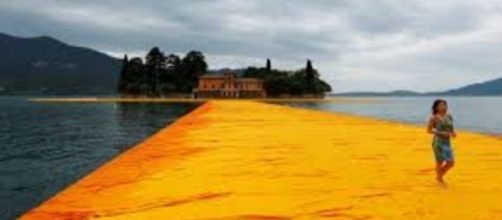Imagine making art that costs a ton of money, takes up a ton of public space, isn’t meant to last or have any meaning, yet is more popular than anything showing in a museum. Can something so meaningless be called art? Well, if you’re just talking about pricy work without a philosophy, there’s always Impressionism, which consistently draws record crowds, even though it amounts to nothing more than sightings of weather conditions – sunshine, fog and wind. Just add in public space projects with a short shelf life, and you get Environmental Art. A recent example is Christo’s “Floating Piers” installed on a lake in northern Italy that boasted visitor attendance of 1.2 million people – 75,000 a day last year – and in only the 16 days the work lasted.
A walk on water
“Floating Piers,” which linked two small islands with pontoons wrapped in almost two miles of orange-colored silk, enabled people to Walk On Water by way of what amounted to a large shiny sandbar, except instead of being formed by currents, it was man-made -- though as temporary as tides. The “is it art” question continues to nag. But to hear Christo tell it to the press, his idea was to help people see the environment in a fresh way. Otherwise, he acknowledges that “Floating Piers” “doesn’t serve for anything except to be a work of art that needs to be experienced.” There’s that “art” word again.
Art for free
At least he doesn’t charge for the experience. The simulated walk on water event cost some $18 million to produce and zero dollars to visitors, governments or anyone else.
Christo paid for it himself with sales of the only work that doesn’t disappear, such as his preparatory drawings and plans. He creates Environmental Art a lot. Other works besides the “Floating Piers” include wrapping the Pont Neuf in Paris and the Reichstag in Berlin in a million square feet of silk. Again, is it art?
Christo believes it is, calling his silken sandbar “very painterly, like an abstract painting.”
Who needs it?
But he’s aware that he may sound a little kooky to some: “I know these projects are totally irrational, totally useless, the world can live without them, nobody needs them.” Come to think of it, one can say the same thing about all art.
Even great painting and sculpture is useless. It’s as if Christo’s work is making a point about art in general -- to prompt people to see something more than the functionality of, say, making money or making a name for oneself. And by dismantling “Floating Piers” after 16 days, he demonstrated that his art is like nature: it doesn’t last, but that doesn’t mean it isn’t an experience to be enjoyed. And maybe the best part of the “art” experiences he provides is that nobody gets to own it, not even the one who made it.


